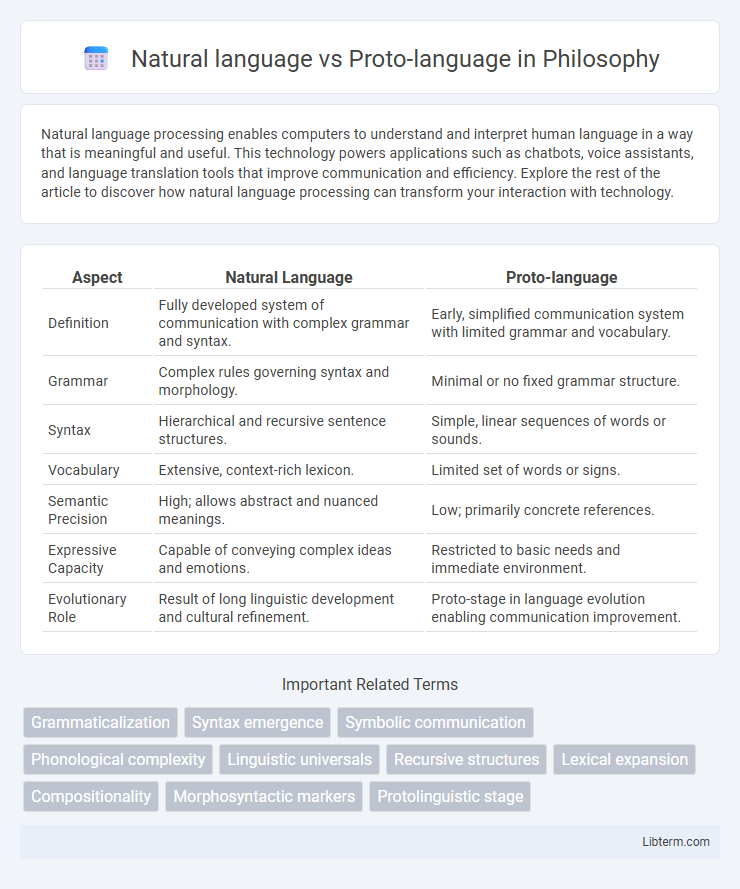Natural language processing enables computers to understand and interpret human language in a way that is meaningful and useful. This technology powers applications such as chatbots, voice assistants, and language translation tools that improve communication and efficiency. Explore the rest of the article to discover how natural language processing can transform your interaction with technology.
Table of Comparison
| Aspect | Natural Language | Proto-language |
|---|---|---|
| Definition | Fully developed system of communication with complex grammar and syntax. | Early, simplified communication system with limited grammar and vocabulary. |
| Grammar | Complex rules governing syntax and morphology. | Minimal or no fixed grammar structure. |
| Syntax | Hierarchical and recursive sentence structures. | Simple, linear sequences of words or sounds. |
| Vocabulary | Extensive, context-rich lexicon. | Limited set of words or signs. |
| Semantic Precision | High; allows abstract and nuanced meanings. | Low; primarily concrete references. |
| Expressive Capacity | Capable of conveying complex ideas and emotions. | Restricted to basic needs and immediate environment. |
| Evolutionary Role | Result of long linguistic development and cultural refinement. | Proto-stage in language evolution enabling communication improvement. |
Introduction to Language Evolution
Natural language represents fully developed communication systems with complex grammar and syntax, evolving over tens of thousands of years in human societies. Proto-language refers to hypothetical early stages of language with rudimentary structure and limited vocabulary, serving as a crucial evolutionary bridge between primate communication and modern languages. Studying proto-language provides insights into the cognitive and social developments that underpin the emergence of natural languages in human evolution.
Defining Natural Language
Natural language refers to the complex, fully developed system of communication used by humans, characterized by rich syntax, semantics, and grammar that enables the expression of abstract and concrete concepts. Unlike proto-languages, which are hypothesized ancestral systems with limited vocabulary and simplified structures, natural languages show spontaneous evolution and diversification across cultures and regions. Natural languages are capable of infinite generativity, allowing speakers to create and understand an unlimited number of novel sentences.
Understanding Proto-language
Proto-language represents an early, simplified form of communication that predates complex natural languages, characterized by limited vocabulary and rudimentary syntax. Understanding proto-language involves analyzing linguistic reconstructions and comparative methods to identify shared ancestral elements in contemporary languages. This foundational insight helps researchers trace the evolution of human language, revealing the cognitive and social capacities of early humans.
Key Differences Between Natural Language and Proto-language
Natural language comprises fully developed systems with complex grammar, syntax, and vocabulary used for everyday communication across cultures, while proto-language is a hypothetical or simplified precursor with limited structure and vocabulary. Natural languages exhibit recursive syntax and nuanced semantic meanings, enabling abstract thought and creativity, whereas proto-languages lack hierarchical organization and are often context-dependent. The evolution from proto-language to natural language involves increased complexity, standardization, and the emergence of formalized linguistic rules.
Historical Development of Human Communication
Natural language evolved gradually from proto-languages, representing a significant leap in the complexity and structure of human communication. Proto-languages likely consisted of rudimentary vocal signals and gestures, serving as foundational systems for conveying basic ideas before the emergence of fully developed grammar and syntax. Archaeological and linguistic studies suggest that the transition from proto-language to natural language involved incremental cognitive and social advancements, enabling abstract thought and cultural transmission across generations.
Linguistic Features of Proto-languages
Proto-languages exhibit foundational linguistic features such as a limited phoneme inventory, simple morphological structures, and basic syntactic patterns that serve as the precursor to natural languages. These early language forms often rely on root words with minimal affixation, showcasing a predominantly agglutinative or isolating morphology. Understanding proto-language structures provides insight into language evolution, revealing how complex grammar systems and extensive vocabularies in natural languages gradually developed from these simpler linguistic frameworks.
Syntax and Grammar: Progression from Proto to Natural
Proto-languages exhibit minimal syntax and simplified grammatical structures, often relying on isolated words or rudimentary phrase patterns, whereas natural languages demonstrate complex syntactic rules and hierarchical grammar. The progression from proto-language to natural language involves the development of morphological markers, word order conventions, and recursive syntax that enable abstract and nuanced communication. This evolution enhances expressive capacity, allowing natural languages to encode tense, aspect, mood, and syntactic dependencies absent in proto-language structures.
Cognitive Implications of Language Development
Natural language exhibits complex syntactic structures and extensive vocabulary, reflecting advanced cognitive abilities such as abstract thinking and symbolic representation. Proto-languages, hypothesized as early linguistic systems, demonstrate simpler communication forms that indicate rudimentary cognitive functions related to social coordination and basic concept formation. The progression from proto-language to natural language suggests significant neurological and cognitive advancements, including enhanced memory, theory of mind, and intricate information processing.
Case Studies: Evidence from Linguistic Anthropology
Case studies in linguistic anthropology reveal that natural languages exhibit complex syntax, morphology, and phonetics, unlike proto-languages which are hypothesized as simplified ancestral forms with limited grammatical structures. Evidence from fieldwork on indigenous communities shows natural languages evolve through social interaction and cognitive processes, while proto-languages often serve as theoretical models reconstructed via comparative methods. These case studies highlight the dynamic nature of natural language development compared to the static and hypothetical status of proto-languages in linguistic evolution.
Future Directions in Language Evolution Research
Future directions in language evolution research emphasize refining computational models to simulate proto-language transitions into complex natural languages, integrating interdisciplinary data from genetics, archaeology, and cognitive science. Advances in neuroimaging technologies promise deeper insights into the brain mechanisms underlying language acquisition and processing, bridging gaps between proto-language functionalities and modern linguistic abilities. Large-scale corpus analyses combined with AI-driven semantic mapping will enhance understanding of gradual language structure development and semantic shifts over millennia.
Natural language Infographic

 libterm.com
libterm.com